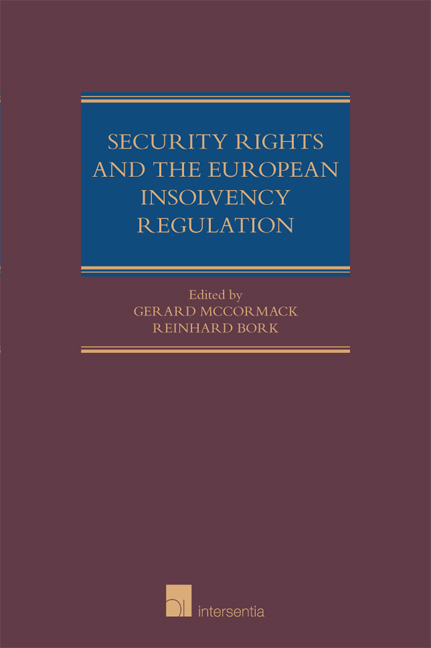Book contents
- Frontmatter
- Disclaimer
- Preface
- Contents
- Questionnaire
- Table of Cases
- Table of Abbreviations
- Part I Comparative Analysis
- Introduction
- Chapter 1 Security Rights under Article 5 of the Insolvency Regulation and Article 8 of theRecast
- Chapter 2 Transactional Avoidance and the Insolvency Regulation
- Chapter 3 Security Rights, National Laws and Possible Reforms
- Chapter 4 Transactional Avoidance, National Laws and Possible Reforms
- Part II National Reports
- Index
- List of Authors
Chapter 1 - Security Rights under Article 5 of the Insolvency Regulation and Article 8 of theRecast
from Part I - Comparative Analysis
Published online by Cambridge University Press: 21 September 2018
- Frontmatter
- Disclaimer
- Preface
- Contents
- Questionnaire
- Table of Cases
- Table of Abbreviations
- Part I Comparative Analysis
- Introduction
- Chapter 1 Security Rights under Article 5 of the Insolvency Regulation and Article 8 of theRecast
- Chapter 2 Transactional Avoidance and the Insolvency Regulation
- Chapter 3 Security Rights, National Laws and Possible Reforms
- Chapter 4 Transactional Avoidance, National Laws and Possible Reforms
- Part II National Reports
- Index
- List of Authors
Summary
INTRODUCTION
This chapter critically evaluates the protection given to secured creditors by the Insolvency Regulation (EIR) – both in its‘ original’ and‘ recast’ versions – Regulation 1346/2000 and Regulation (EU) 2015/848. It will assess the validity of the criticism that the protection is over-broad and also look at possible ways forward in any future revision of the Regulation by the European Commission.
The Regulation establishes a detailed framework for the management of cross-border insolvency cases within Europe. It also goes some way towards harmonising conflicts-of-law rules. It does not, however, harmonise substantive insolvency law or the law relating to security rights. Its centralising mission stops short in this regard. The Regulation puts the law of the State where the debtor has its centre of main interests (COMI) at the heart of the insolvency administration process. The COMI State is centre stage when it comes to collection and administration of the debtor‘s assets, surveying the debtor‘s legal affairs and the effect of the insolvency on other parties. Security rights, or‘rights in rem’ as they are referred to in the Regulation, are however at least partially immunised from the centralising effects of the COMI. The Regulation is said to establish a‘hard and fast’ rule in this respect.
In addition to the Introduction, this chapter consists of four main sections, though section 4 is considerably larger than the others. Section 2 will examine the philosophy of the European Insolvency Regulation. Section 3 looks at the nature of security rights and what they can do for you. Section 4 contains a detailed analysis of the protection of security rights in rem under Article 5 (Article 8 of recast). It is divided into five subsections as follows:
• what counts as a‘right in rem’ ;
• encumbered assets;
• location of encumbered asset;
• Article 5 as a substantive rule restricting the effects of the insolvency proceedings;
• conclusions on the interpretation of Article 5.
Finally, section 5 addresses options for reform.
- Type
- Chapter
- Information
- Publisher: IntersentiaPrint publication year: 2017



